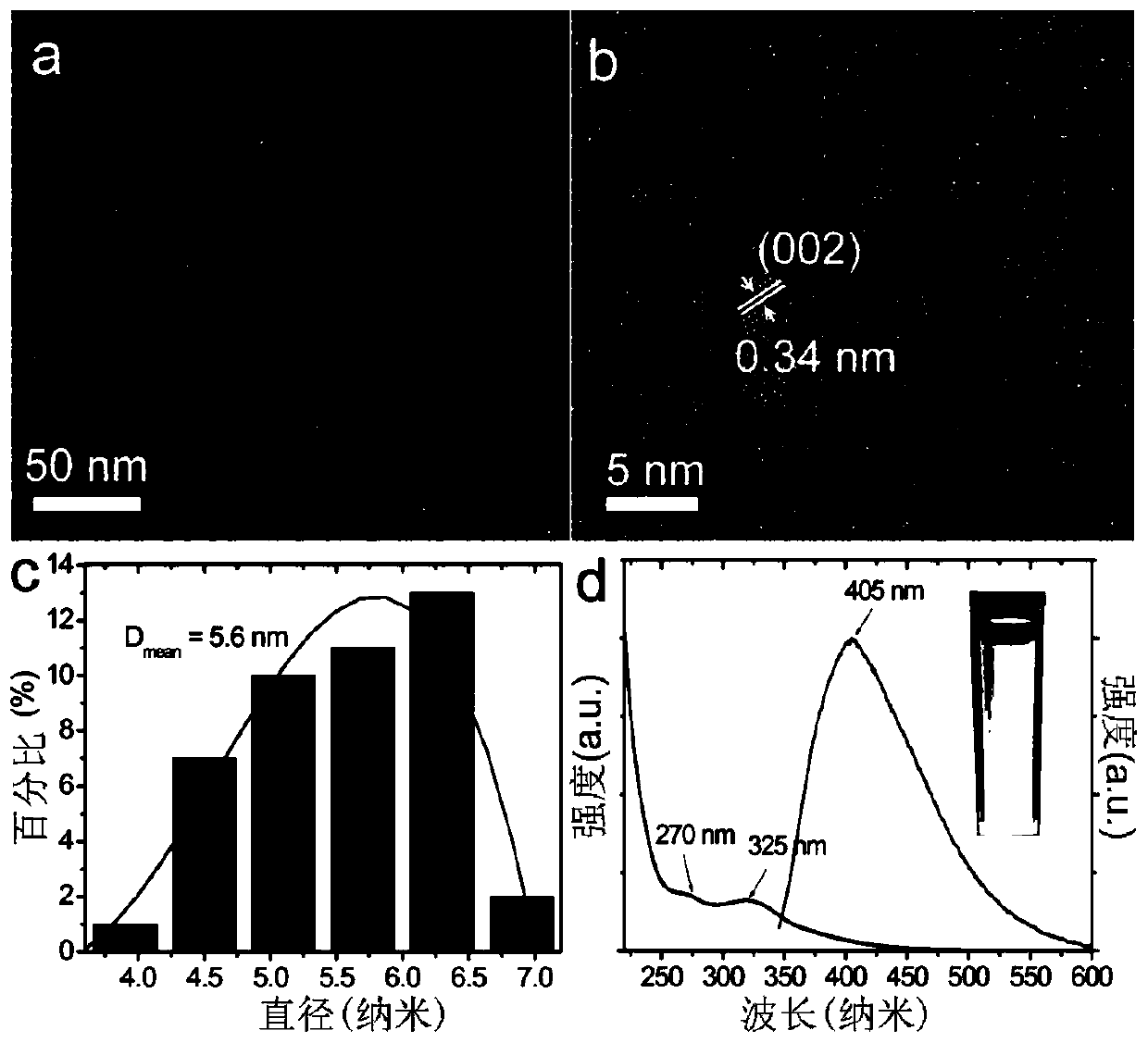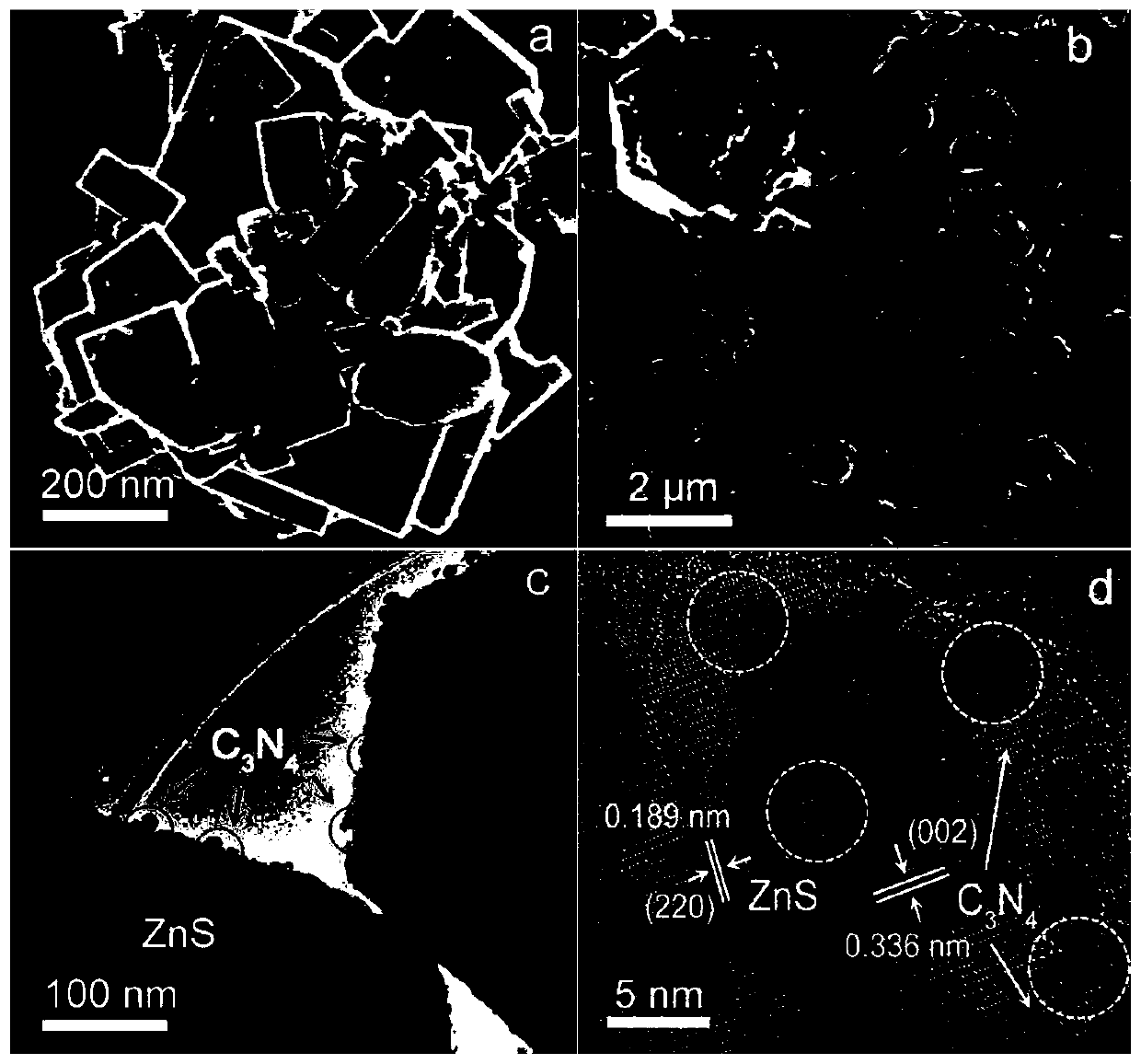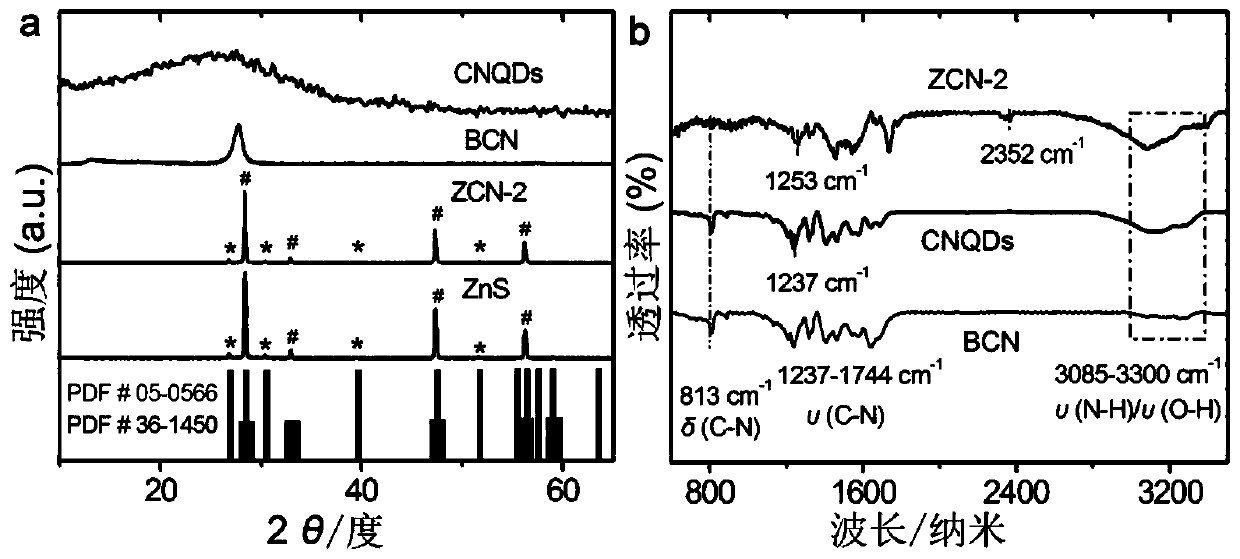Graphene nitrogen carbide quantum dot modified zns microcomposite material and its preparation method and application
A technology of carbonized nitrogen and composite materials, which is applied in the field of ZnS micro-composite materials modified by graphene carbonized nitrogen quantum dots and its preparation, which can solve the problems of complex preparation methods and easy aggregation of quantum dots
- Summary
- Abstract
- Description
- Claims
- Application Information
AI Technical Summary
Problems solved by technology
Method used
Image
Examples
preparation example Construction
[0031] The present invention at first provides a kind of preparation method of the ZnS micro-composite material of graphene carbonized nitrogen quantum dot modification, and this method comprises:
[0032] Step 1: Preparation of ZnS(en) 0.5 Nanosheets, specifically: adding zinc salt and thiourea into ethylenediamine, stirring, the stirring time is preferably 30 minutes, and then hydrothermally reacting at 180-200°C for 10-24 hours, the reaction temperature is preferably 180°C, the reaction time is preferably 18h, after cooling, washing and drying, ZnS(en) can be obtained 0.5 Nanosheets; the zinc salt is preferably zinc chloride, zinc nitrate or zinc acetate; the mass ratio of the zinc salt to thiourea is preferably 272.6:304; the washing is preferably the reactant with ethanol and water Wash each for 2-3 times, the drying temperature is preferably 60-80°C, and the drying time is preferably 10-12h;
[0033] Step 2: Add the amino compound into the porcelain boat, put it in a t...
Embodiment 1
[0042] Example 1g-C 3 N 4 Preparation of QDs
[0043] Add 100 mg of melamine into the porcelain boat, put it in a tube furnace, heat at 550 ° C for 4 hours under nitrogen atmosphere, and the heating rate is 2.5 ° C per minute to obtain the bulk phase g-C 3 N 4 Yellow powder, mix 100mg g-C 3 N 4 The powder was dissolved in 50mL deionized water and stirred for 60min, then transferred to a 100mL reactor and reacted at 200°C for 6h to obtain a light yellow g-C 3 N 4 QDs transparent solution.
[0044] figure 1 g-C prepared for Example 1 3 N 4 Transmission (a), high-resolution photo (b), size distribution (c) and absorption and fluorescence curves (d) of QDs; from figure 1 It can be seen that g-C 3 N 4 QDs have good dispersion, and the crystal lattice is obvious in high-resolution photos, indicating good crystallinity, with an average particle diameter of 5.6nm, blue light emission, absorption and fluorescence, and bulk g-C 3 N 4 Compared with the obvious blue shift, i...
Embodiment 2
[0046] 1. Preparation of ZnS(en) 0.5
[0047] First 272.6mg ZnCl 2 and 304mg of thiourea were added to 60mL of ethylenediamine, stirred for 30min, hydrothermally reacted at 180°C for 18h, cooled to room temperature, washed with ethanol and water for 2-3 times, and dried at 60°C for 12h.
[0048] 2. Preparation of bulk g-C 3 N 4
[0049] Add 100 mg of melamine into the porcelain boat, put it in a tube furnace, heat at 550 ° C for 4 hours under nitrogen atmosphere, and the heating rate is 2.5 ° C per minute to obtain the bulk phase g-C 3 N 4 yellow powder.
[0050] 3. Synthesis of ZCN-0.5
[0051] Take the above ZnS(en) 0.5 Nanosheets and g-C 3 N 4 Powder, where ZnS(en) 0.5 Nanosheets and g-C 3 N 4 The molar ratio of the powder is 1.0:0.5, mixed and stirred for 60 minutes, heated in a reactor at 200°C for 6 hours, then transferred to a dialysis bag for dialysis for 24 hours, and the resulting product was freeze-dried to obtain ZCN-0.5.
[0052] Photocatalytic hydro...
PUM
| Property | Measurement | Unit |
|---|---|---|
| band gap | aaaaa | aaaaa |
Abstract
Description
Claims
Application Information
 Login to View More
Login to View More - R&D
- Intellectual Property
- Life Sciences
- Materials
- Tech Scout
- Unparalleled Data Quality
- Higher Quality Content
- 60% Fewer Hallucinations
Browse by: Latest US Patents, China's latest patents, Technical Efficacy Thesaurus, Application Domain, Technology Topic, Popular Technical Reports.
© 2025 PatSnap. All rights reserved.Legal|Privacy policy|Modern Slavery Act Transparency Statement|Sitemap|About US| Contact US: help@patsnap.com



